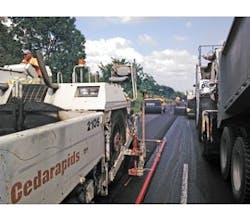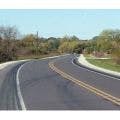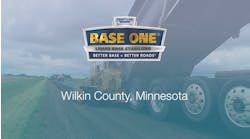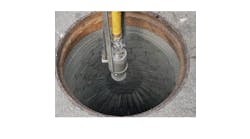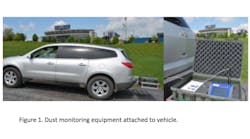By: Jeff Zagoudis
Norris Asphalt Paving Co. faced an uphill climb to qualify as a finalist for the 2015 Sheldon G. Hayes Award, but in the end the company was able to make its way to the top.
The Ottuma, Iowa-based company was nominated for the asphalt paving industry’s highest honor thanks to its exemplary work on U.S. 34, a two-lane highway in Wapello County, Iowa, in 2013.
Paving the “Super” highway
The Iowa DOT wanted the slope and smoothness of U.S. 34 corrected over a 9.5-mile stretch, and specified cold in-place recycling (CIR) as the required method for doing so. The state also was looking to standardize the width of its roadways out to 16 ft, so new paved shoulders were added to the project list. Finally, more than 13,000 ft of new cable guardrail also was installed.
The catch? This section of U.S. 34 meanders through a very hilly, wooded environment. The highway is classified as a “Super 2” in the Iowa system, with the numerous twists and turns precluding passing for long stretches—an extra lane is added every mile or two for that purpose.
And the passing lanes weren’t the only problem—the climbing lanes also ran right through some of the most sloped parts of the roadway, and overlapped a significant portion of the job. “A lot of those climbing lanes have gore areas, or areas where the roadway starts out very narrow and then shifts out to the full width of the lane,” Brady Meldrem, president of Norris Asphalt, told Roads & Bridges. Because of this layout, achieving the optimal, uniform smoothness was more difficult than usual.
This twisting, hilly topography caused the project team quite a bit of concern from a stability standpoint as well, and erosion control was a major secondary focus as a result. “Because it’s so woody, you realize that when that happens you’ve got a lot of fill sections,” said Meldrem, “some of which are 40-50 ft tall, and they were sliding. So there was probably almost 40,000 tons of erosion stone placed on the job to try to keep that roadway from sliding as well.”
Even with all of the ups and downs provided by the terrain, Meldrem said traffic control proved to be the biggest challenge. “It’s a pretty busy road, and we needed a lot of line-of-sight in order to be able to store the queue of cars that were coming through there,” Meldrem said. “The roadway tends to back up a lot of cars in a hurry.” Flaggers had to be positioned carefully to ensure their safety and that of the motoring public. With all of these measures in place, the project team was able to keep U.S. 34 open and moving throughout the entire span of work.
A cold start
The roadway featured a concrete base with 5 in. of asphalt on top of it. Reflective cracking had started to become an issue, which is why CIR was required for the project. Subcontractor WK Construction of Middleton, Wis., handled the CIR process after Norris widened the roadway so the whole span, including the new shoulders, could be paved at once for uniform smoothness. Each of the seven sections of the project was widened between 2 and 4 ft to either side.
The recycling train was led by a 12-ft Roadtec RX900 milling machine, closely followed by a United Machinery 660HB crusher. The crushed asphalt was then picked up by a CMI TS400 and injected with a 2% foamed asphalt additive and a PG 46-34 binder before being laid back down on the roadway, also at a 12 ft width. A total of 3 in. was added on top of the existing asphalt; recycled asphalt pavement (RAP) content for the CIR layer was 20% in the base and surface lifts and 12% in the intermediate layer.
Work began in mid-April 2013, an unpredictable time of year in the Midwest—temperatures were still fluctuating between late winter and early spring in Iowa as the project began. “That was our first job in the spring of that year, so we definitely had cold-weather challenges,” Bill Kahl, owner of WK Construction, told Roads & Bridges.
Mother Nature threw her worst punch in mid-May, when a freak snowstorm settled into the area over a weekend. As expected, snowplows came through and cleaned out the precipitation—but at the cost of significant damage to the new pavement. “We did half a day’s worth of work on Friday, then came back Monday and ended up having to redo about a mile’s worth of roadway,” Kahl said.
Even with the unexpected cold snap, WK Construction was able to complete the entire CIR portion of the project in just 10 days.
Initial compaction of the CIR layer was handled by a Caterpillar PS360C pneumatic rubber-tire roller, while a Hamm HD130HV vibratory roller went back and finished the job. Because of this process, the subcontractor was able to achieve the target density of 94%.
“Other than the snow problems, it was a pretty normal job for what one would expect,” Kahl reported.
Laying it out
Once the CIR layer was in place, Norris Asphalt came back in to place the surface overlay using a Roadtec R195P paver. The intermediate layer was a ½-in. 3-million-equivalent-single-axle-load (ESAL) mix; the surface layer also was a ½-in. 3-million ESAL mix but it had specific friction requirements that forced the contractor to import aggregates from South Dakota. “We live in an area of limestone that polishes, so when we get to the surface course of busy roads like this one, we often end up having to bring in granite or quartzite to make sure tires can get proper friction,” Meldrem said. The train paved 16 ft across the whole length of the highway, doing one side at a time to limit the impact to traffic.
Meldrem said that the paving itself was fairly uneventful; the real challenge was scheduling the delivery of new materials to the site. To alleviate the situation, the project team ended up using a series of material-transfer vehicles, specifically Roadtec SB2500 Shuttle Buggies.
Norris Asphalt used a total of three rollers on the U.S. 34 project. Hypac vibratory rollers were used to start and finish the compaction—the first was used in a high-frequency, low-amplitude setting, while the second brought up the rear doing vibratory and finish rolling. A 25-ton Ingersoll-Rand pneumatic rubber-tire roller was sandwiched in the middle.
The paving team handled the climbing lanes as a separate job, finishing them after all of the mainline paving was completed. “We’d had some problems in the past achieving our smoothness bonus on the climbing lanes,” Meldrem said, “so this time we decided we were just going to pave right by those and then come back at a later time.” Using this strategy, they were able to side-deliver the new asphalt with a material transfer vehicle, a move that Meldrem estimated improved the smoothness two- to threefold. In the end, Meldrem estimated that Norris Asphalt achieved about 85% of the smoothness bonus for the project.
Once the paving was completed, all that was left was installing the new guardrail. This required extending culverts along the entire stretch of U.S. 34 in addition to extensive slope repair. All work was completed by mid-August 2013, to the satisfaction and approval of all stakeholders. R&B
About The Author: Jeff Zagoudis is contributing author for Roads & Bridges
